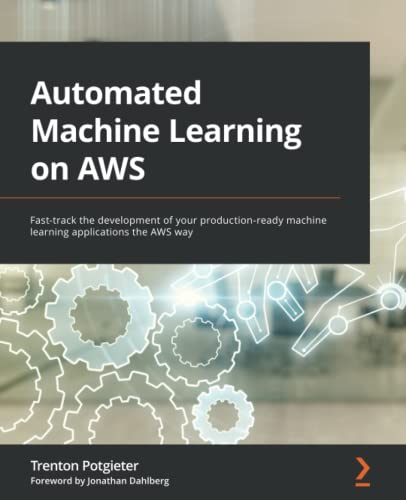Trenton Potgietor is the author of Automated Machine Learning on AWS. We got the chance to sit down with him and find out more about his experience of writing with Packt.
Q: What are your specialist tech area(s)?
Trenton: I am currently and Applied Artificial Intelligence, and Machine Learning Specialist at AWS. My core focus areas within this domain are ML Operations (MLOps), Computer Vision models, Graph Neural Networks, and Hybrid-Classical Quantum Machine Learning.
Q: How did you become an author for Packt? Tell us about your journey. What was your motivation for writing this book?
Trenton: My motivation for this book is to help readers to practically take their qualified ML models into production. There are many examples of models that address specific use cases, with multiple papers (with code), blogs and AWS specific examples of how to automate the building, and training of ML models. However, the majority of these examples don’t practically illustrate what to do with the optimized model. Personally, I’ve spent the last 4 years focusing on ways to further automate this process, from DevOps for ML (before MLOps was even a thing), all the way to modernized MLOps approaches. I became a Packt author in the hopes that I can help readers overcome the many challenges beyond simply building models, to actually delivering them into production, by showcasing various strategies to approach the problem, then practically demonstrate how to create processes to automate these strategies, while using the right AWS technologies, plus the right people to get the job done.
Q: What kind of research did you do, and how long did you spend researching before beginning the book?
Trenton: The research from this book comes from over 4 years of experience in helping AWS customers to operationalize their Machine Learning models into production.
Q: Did you face any challenges during the writing process? How did you overcome them?
Trenton: The biggest challenge during the writing process was time allocation. While Packt provided guidelines for allocating the right amount of time to writing the chapters, I did not factor in the time required to create, configure and test the code artifacts used within each chapter.
Q. What’s your take on the technologies discussed in the book? Where do you see these technologies heading in the future?
Trenton: AWS CloudFormation has always been used to provision cloud infrastructure, requiring users codify their solution using templates. Once of the key differentiators within this book is the use of the AWS Cloud Development Kit (CDK). This toolkit allows developers, Data Scientists, and ML practitioners to codify their AWS architectures using Python, TypeScript, Java, Go and many more languages. I’ve used CDK throughout the book to help explain the reasoning behind and motivation for creating automated architectures to support automating the Machine Learning process. So as Machine Learning continues to become an integral component of any modern application architecture, this book will provide the necessary introduction to the fundamental challenges involved, as well as how to overcome these challenges in a practical, and automated fashion.
Q: Why should readers choose this book over others already on the market? How would you differentiate your book from its competition?
Trenton: There are many books in the market that focus on how to do machine learning, with the primary focus on the various Machine Learning frameworks, and tools. Added to this, the goal of these publication is to primarily show teach the reader how to use these tools within the context of the Machine Learning process. These publications only focus on the task of building, training and optimization Machine Learning models using these tools. Essentially only focusing on the process. Readers should choose this book as it it doesn’t only focus on the modeling process, but rather how to leverage various AWS technologies, and apply these to the actual process. It further highlights the practical challenges that readers will face beyond the process. For example, this book practically illustrates how to automate the Machine Learning process, using AWS technologies, along with applying the domain expertise of front-end developers, back-end developers, business stakeholders, platform engineers, and of course the Machine Learning practitioners, as cross-functional team, which is a critical success factor to any Machine Learning-based endeavor.
Q. What are the key takeaways you want readers to come away from the book with?
Trenton: My primary goal is for readers to see that not only is Machine Learning hard, but operationalizing, the process makes the overall to get models into production even harder. Added to this, the problem is further compounded for readers wishing to automate the entirety of the process. However, it is my hope that readers will see this book as a much needed, practical, and hands-on solution on how to effectively overcome these challenges. for turning data into insight.
Q. What advice would you give to readers learning tech? Do you have any top tips?
Trenton: My only advice to readers is to learn Python. Readers may have programming language preferences, however, not only does Python allow AWS architectures to be codified (using the CDK), but also allows readers to wrangle data, build Machine Learning models, plus the applications that leverage these models. Python provides a vast array of libraries that help the reader to accomplish all of these tasks with a single programming language.
Q. Do you have a blog that readers can follow?
Trenton: I will be building a blog after the book has been published to demonstrate how to use other opensource technologies to reproduce the use case highlighted within the book and build upon the book’s foundation.
Q. Can you share any blogs, websites, and forums to help readers gain a holistic view of the tech they are learning?
Trenton: There are many blog posts available AWS, and medium.com that focus on MLOps and Machine Learning automation. However, my biggest suggestion to readers is to review the SageMaker Examples GitHub Repository (https://github.com/aws/amazon-sagemaker-examples), especially the examples in the “end_to_end” folder. Additionally I would recommend readers review the AWS Blog (https://aws.amazon.com/blogs/machine-learning/orchestrate-custom-deep-learning-hpo-training-and-inference-using-aws-step-functions/) that highlights how to create a portal for non-technical users to build Machine Learning models. Lastly, I would recommend user review the CDK workshop (https://cdkworkshop.com/) to get started with the CDK, using their programming language of choice.
Q. How would you describe your author journey with Packt? Would you recommend Packt to aspiring authors?
Trenton: I would definitely recommend Packt to aspiring authors. Before writing this book, I a fairly good idea of how to present and articulate the subject matter of automating Machine Learning. However, after completing this book, I’ve realized that I pretty much didn’t have a clue on how to translate my knowledge into a book. The Packt editors, reviewers and project managers guided me on how to take my subject matter expertise and convey this knowledge into a book format. I can honestly say that without the Packt team I could not have written this book.
Q. Do you belong to any tech community groups?
Trenton: Yes, I belong to the Deep Learning Facebook group (https://www.facebook.com/groups/DeepLearnng/), founded by Andrew Ng, and Geoffrey Hinton and others.
Q. What are your favorite tech journals? How do you keep yourself up to date on tech?
Trenton: I stay up to date in the field of quantum computing by reading Quantum Zetgeist (https://quantumzeitgeist.com/). I read Papers with Code (https://paperswithcode.com/) daily to stay up to date with the latest trending research.
Q. How did you organize, plan, and prioritize your work and write the book?
Trenton: To coordinate the writing of the book, I followed the Packt guidelines of allocating three hours a day (during the week) to focus on chapter content. I also allocated 8 – 12 hours every weekend to build and test the supporting code.
Q. What is the one writing tip that you found most crucial and would like to share with aspiring authors?
Trenton: When scheduling time to write the book, make sure to bundle in the the time requirements to build, and test the code within the chapters.
You can find Trenton’s book on Amazon by following this link: Please click here.









